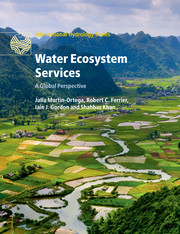Book contents
- Frontmatter
- Contents
- List of contributors
- Preface
- 1 Introduction
- 2 What defines ecosystem services-based approaches?
- Part I Addressing global challenges
- Part II Applying frameworks for water management and biodiversity conservation under an ecosystem services-based approach
- Part III Assessing water ecosystem services
- 9 The first United Kingdom's National Ecosystem Assessment and beyond
- 10 Using an ecosystem services-based approach to measure the benefits of reducing diversions of freshwater: a case study in the Murray-Darling basin, Australia
- 11 An ecosystem services-based approach to integrated regional catchment management: the South East Queensland experience
- 12 Policy support systems for the development of benefit-sharing mechanisms for water-related ecosystem services
- 13 Assessing biophysical and economic dimensions of societal value: an example for water ecosystem services in Madagascar
- 14 Rapid land use change impacts on coastal ecosystem services: a South Korean case study
- Part IV Broadening the perspective
- Index
- Plate Section
- References
13 - Assessing biophysical and economic dimensions of societal value: an example for water ecosystem services in Madagascar
from Part III - Assessing water ecosystem services
Published online by Cambridge University Press: 05 May 2015
- Frontmatter
- Contents
- List of contributors
- Preface
- 1 Introduction
- 2 What defines ecosystem services-based approaches?
- Part I Addressing global challenges
- Part II Applying frameworks for water management and biodiversity conservation under an ecosystem services-based approach
- Part III Assessing water ecosystem services
- 9 The first United Kingdom's National Ecosystem Assessment and beyond
- 10 Using an ecosystem services-based approach to measure the benefits of reducing diversions of freshwater: a case study in the Murray-Darling basin, Australia
- 11 An ecosystem services-based approach to integrated regional catchment management: the South East Queensland experience
- 12 Policy support systems for the development of benefit-sharing mechanisms for water-related ecosystem services
- 13 Assessing biophysical and economic dimensions of societal value: an example for water ecosystem services in Madagascar
- 14 Rapid land use change impacts on coastal ecosystem services: a South Korean case study
- Part IV Broadening the perspective
- Index
- Plate Section
- References
Summary
13.1 INTRODUCTION
Policy decisions are often based on an assessment of value. However, the definition of value is highly context-dependent and policy decisions are ultimately a multiple-objectives problem, containing internal trade-offs that make alternative actions difficult to assess and rank. This chapter provides a demonstration of how to operationalize an ecosystem services-based approach, as defined in Chapter 2 of this book, to assess the social and economic value of water from a pluralistic viewpoint that can better support decision-making. Our approach to the biophysical analysis emphasizes explicitly identified beneficiaries (core element 1) along with an assessment and mapping of physical flows to them (core element 2). The biophysical interpretation is complemented by an analysis of economic productivity of water and by a policy analysis where the biophysical and economic analysis are integrated and discussed (core element 3), and implications of alternative management scenarios (protected versus non-protected areas) are addressed (core element 4). Notably, we quantify four key dimensions of ecosystem services, moving beyond the purely economic viewpoint that has dominated the policy translation of ecosystem services assessments so far. These are:
• Input productivity: the relationship between inputs and final output, estimated in this study as water productivity in four selected economic sectors.
• Economic value: the value of marginal productivity, in terms of the increases in economic productivity with the increase of an additional unit of input (in this case, per additional unit of water).
• Sustainability of supply: defined as the ratio between the amounts of ecosystem-provided benefit (here: water services) and the estimated maximum demand that can be met for it in the same conditions.
• Quality of supply: estimated by assessing the influence of the natural environment in preserving the quality of the ecosystem service.
Our study was performed in the context of a World Bank-led global initiative that aims to integrate natural capital values into national account systems.
- Type
- Chapter
- Information
- Water Ecosystem ServicesA Global Perspective, pp. 110 - 118Publisher: Cambridge University PressPrint publication year: 2015
References
- 1
- Cited by



